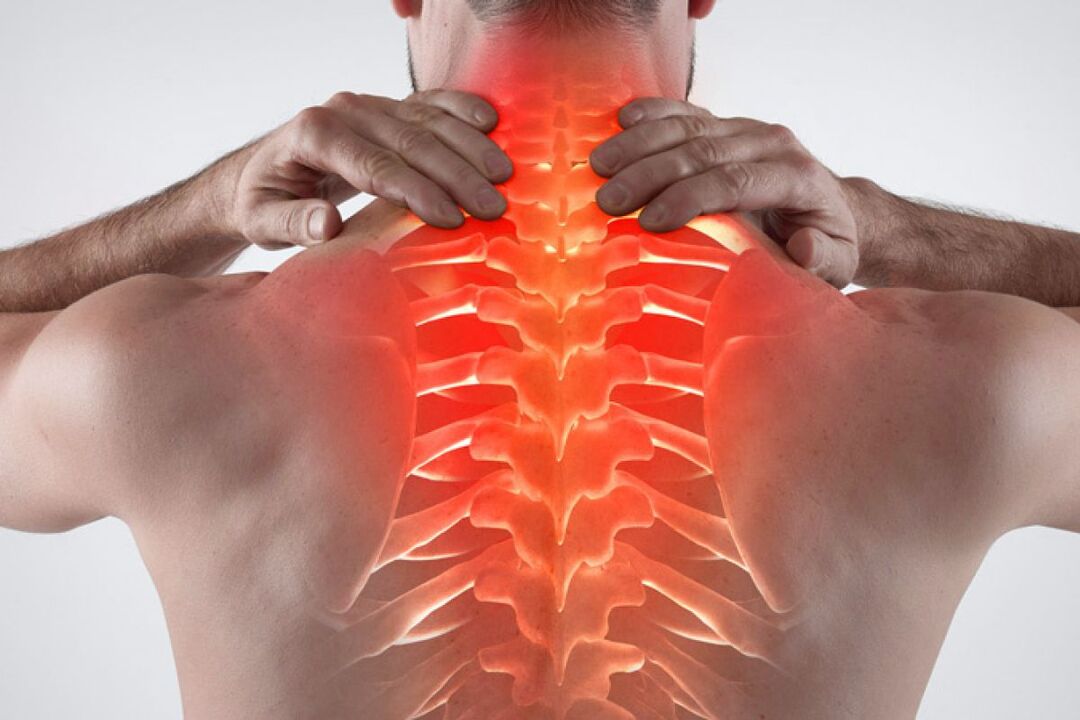Dystrophic as well as degenerative processes in the human spine usually lead to the appearance of a disease such as osteochondrosis. It can affect one segment of the pathological chain or the entire spine. Certain parts of the spine are affected more often, and some less.

In the thoracic region of the spine, the vertebrae differ in strength and are larger than the others. In addition, this part of the chain has less mobility, less stress, and the muscles support the skeleton perfectly.
Defeat of thoracic osteochondrosis is less commonly diagnosed. This pathology usually persists with symptoms similar to those of many diseases and is classified by degree depending on the degree of destruction of the intervertebral discs.
Grade 1 osteochondrosis of the chest: symptoms
In patients suffering from the initial stage of thoracic osteochondrosis, a decrease in the elasticity of the discs between the vertebrae of the spine is observed. Possible protrusion of the fibrous ring.
The following symptoms can be observed in the early stages of the disease:
- the patient suffers from acute penetrating pain. Occurs after physical activity, tension, or lifting heavy objects. The pain is painful, constant, not intense, accompanied by lumbago;
- As a result of the high load, an unexpected rupture of the capsule occurs in the intervertebral disc and cracks appear. As a result, the nucleus penetrates through the cracks, irritating the nerves in the spine;
- The degree of this disease is clearly accompanied by muscle tension. As a result, the space in the intervertebral discs narrows further and the pain intensifies.
Thoracic osteochondrosis can occur with pain in the heart, digestive organs, kidneys. At this stage of the disease, the symptoms disappear and it is difficult to diagnose.
Treatment of first-degree thoracic osteochondrosis
Early treatment of thoracic osteochondrosis is easier. Treatment of the disease aims to eliminate the manifestations of the disease and heal the capsule hernia.
Because inflammatory processes occur in the tissues, causing severe pain, treatment begins with the use of painkillers in tablet or injectable form.
Medications that help dilate blood vessels are prescribed to relieve spasms in the affected part of the spine and increase blood flow. Daily intravenous administration of sodium chloride will help eliminate swelling. The duration of such therapy is 5 days.
In addition, chondroprotectors are prescribed for treatment. These drugs affect the affected areas and help regenerate tissues.
Doctors often prescribe non-steroidal anti-inflammatory drugs to stop the inflammation. However, it should be borne in mind that the use of these drugs can aggravate the existing chronic diseases, especially pathologies of the gastrointestinal tract. Therefore, the duration of non-steroidal drugs should not exceed 10 days.
All medications should only be prescribed by a physician. To achieve positive results, the patient must strictly follow all the recommendations of the doctor: the dose, time of medication and duration of treatment.
All drugs prescribed for treatment can be classified as:
- antihistamines;
- non-steroidal anti-inflammatory drugs;
- vasoactive substances.
The patient is advised to follow a month of bed rest, undergo physiotherapy procedures.
It is important to remove the series for prophylactic purposes. You do not need to go to the gym for this. There is always a suitable horizontal bar on any sports field. It is recommended to hang for a few minutes once a day. This procedure helps to relieve stress from the intervertebral discs of all zones of the chain.
Osteochondrosis of the thoracic spine grade 2: symptoms
If the disease is not betrayed in the early stages and treatment is not started, the disease progresses to the 2nd degree. With this pathology, there is a subsequent decrease in the elasticity of the discs between the vertebrae, hernias may occur, and narrowing of the intervertebral foramina is observed. The second stage of the disease is characterized by neurological syndrome, as well as painful sensations.
This stage of the disease is difficult to diagnose and continues with symptoms similar to heart attack, angina pectoris or pneumonia.
The following symptoms of thoracic osteochondrosis grade 2 should be noted:
- constant pain in the affected area;
- arterial hypotension may be observed;
- unnatural mobility of the ridge is visible;
- joint mobility increases as a result of capsule thinning;
- scoliosis occurs due to instability of the spine;
- the vessels of the spinal cord are gradually affected.
Pain occurs with grade 2 thoracic osteochondrosis:
- in the chest. Such pains intensify after a long stay in one position;
- in the interscapular zone of the back;
- with deep breathing or exhalation;
- when turning, as well as when bending the body, raising the arms.
With this pathology there is a feeling of tightness in the sternum, as well as stiffness.
Grade 2 disease can occur with intestinal pathologies, shortness of breath. The patient complains of peeling skin, headache, pain in the heart area.
This pathology can last for years, with periods of exacerbation and remission varying.
Treatment of grade 2 thoracic osteochondrosis
The disease requires urgent comprehensive treatment. The doctor prescribes anti-inflammatory drugs to relieve pain. Manual therapy sessions, as well as massage are prescribed for the effectiveness of therapy. These procedures improve the blood supply to the spine.
Timely therapy can significantly slow down pathological processes in the spine and in some cases completely stop the development of osteochondrosis.
Thoracic osteochondrosis of the spine is often mistaken for heart pathology or other diseases. When the first manifestations appear, it is necessary to consult a doctor for a differential diagnosis of osteochondrosis from various diseases and the appointment of effective treatment.


















































